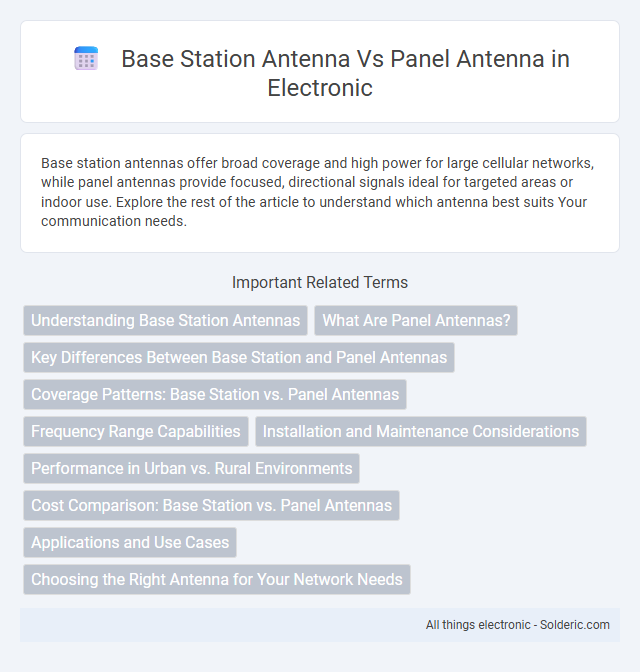Base station antennas offer broad coverage and high power for large cellular networks, while panel antennas provide focused, directional signals ideal for targeted areas or indoor use. Explore the rest of the article to understand which antenna best suits Your communication needs.
Comparison Table
| Feature | Base Station Antenna | Panel Antenna |
|---|---|---|
| Primary Use | Wireless communication infrastructure | Directional signal transmission and reception |
| Design | Omnidirectional or sector antennas | Flat, rectangular shape |
| Coverage | Wide area coverage | Focused, narrow beam coverage |
| Frequency Range | Typically 700 MHz to 2.7 GHz | Varies, commonly 600 MHz to 6 GHz |
| Gain | Moderate (8-15 dBi) | High (10-18 dBi) |
| Installation | Mounted on towers or poles | Wall or pole-mounted, easier installation |
| Applications | Cellular networks, macro coverage | Small cells, indoor/outdoor targeted coverage |
| Cost | Higher initial investment | More cost-effective |
Understanding Base Station Antennas
Base station antennas are critical components in cellular networks, designed to transmit and receive signals over large areas to maintain coverage and capacity. Panel antennas, a common type of base station antenna, offer directional signal transmission with high gain, improving network performance in targeted sectors. Understanding the differences helps you optimize network design and ensure efficient signal propagation for reliable communication.
What Are Panel Antennas?
Panel antennas are flat, rectangular devices designed for directional signal transmission in wireless communication systems, commonly used in base stations to enhance network coverage and capacity. These antennas focus radio waves into a narrow beam, allowing for efficient targeting of specific areas or users, which reduces interference and improves signal quality. Compared to other types such as omni-directional base station antennas, panel antennas provide higher gain and better control over signal direction, making them ideal for sectorized cellular networks.
Key Differences Between Base Station and Panel Antennas
Base station antennas are designed for broader coverage with high gain, supporting multiple frequency bands and sectorized deployment in cellular networks, while panel antennas offer narrower, more focused beams ideal for point-to-point or limited area coverage. Base station antennas typically feature larger arrays enabling higher elevation and azimuth beamwidth control, whereas panel antennas are compact with fixed directional patterns suited for indoor or small cell environments. The main differences lie in their application scope, gain patterns, and physical design tailored to network topology and coverage requirements.
Coverage Patterns: Base Station vs. Panel Antennas
Base station antennas typically offer omnidirectional or sectorized coverage patterns designed to support wide-area network distribution, ideal for cellular base stations serving multiple users across large geographic regions. Panel antennas, however, provide highly directional coverage with narrow beamwidths, enabling focused signal transmission that enhances capacity and reduces interference in targeted areas such as urban environments or indoor spaces. The choice between base station and panel antennas depends on optimizing coverage uniformity versus directional signal strength to meet specific network deployment requirements.
Frequency Range Capabilities
Base station antennas typically support a broader frequency range, covering multiple bands such as 700 MHz to 2700 MHz, enabling versatile deployment across various cellular technologies including 4G and 5G. Panel antennas generally operate within narrower frequency bands, optimized for specific applications like LTE or mmWave in 5G networks, offering enhanced gain and directional performance. Understanding the frequency range capabilities of your antenna choice ensures optimal network coverage and capacity tailored to your wireless infrastructure requirements.
Installation and Maintenance Considerations
Base station antennas typically require elevated, well-structured tower installations to optimize coverage and signal strength, demanding specialized equipment and skilled technicians for both setup and routine maintenance. Panel antennas, often surface-mounted on building facades or poles, offer easier access and simpler maintenance due to their lower weight and compact size, reducing labor time and costs. Choice between the two impacts maintenance schedules and installation complexity, with base station antennas being more resource-intensive.
Performance in Urban vs. Rural Environments
Base station antennas deliver robust performance in both urban and rural settings by providing wider coverage and better signal penetration through obstacles, making them ideal for large-area communication networks. Panel antennas, with their directional focus, excel in urban environments by targeting specific sectors and reducing interference, leading to enhanced capacity and data throughput in dense cellular deployments. Rural areas benefit more from base station antennas due to their broader beamwidth and higher gain, effectively covering long distances and overcoming sparse infrastructure challenges.
Cost Comparison: Base Station vs. Panel Antennas
Base station antennas generally have higher initial costs due to their complex design and broader coverage capabilities, whereas panel antennas are typically more affordable and easier to install for targeted coverage areas. Maintenance expenses for base station antennas can be greater given their size and complexity, while panel antennas often incur lower upkeep costs. Choosing between the two depends on budget constraints and specific network deployment requirements.
Applications and Use Cases
Base station antennas are primarily deployed in macrocell environments for wide-area coverage, supporting mobile network operators in urban and rural regions to provide reliable cellular connectivity. Panel antennas are suited for focused coverage areas such as stadiums, office buildings, and indoor hotspots, offering directional signal transmission that enhances capacity and reduces interference. Both antenna types are integral in 4G and 5G deployments, with base station antennas enabling broad network reach and panel antennas optimizing performance in high-density or targeted zones.
Choosing the Right Antenna for Your Network Needs
Base station antennas offer wide coverage and higher gain ideal for large-scale cellular networks, while panel antennas provide directional focus suitable for targeted coverage areas and improved signal quality. Your choice depends on network scale, coverage requirements, and environmental factors such as interference and physical obstacles. Optimizing antenna type ensures enhanced connectivity, capacity, and overall network performance tailored to your specific infrastructure.
base station antenna vs panel antenna Infographic

 solderic.com
solderic.com